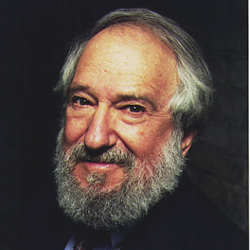
Seymour Papert, a South African-born American mathematician, computer scientist, and educator who anticipated the use of computers to educate children and stimulate their creativity, died at his home in Blue Hill, Maine, on July 31, 2016, at the age of 88.
Papert’s career encompassed research and development into areas as seemingly diverse as child development, artificial intelligence, and educational technologies.
Born in 1928 in Pretoria, South Africa, Papert attended the University of the Witwatersrand in South Africa, where he earned a B.A. in philosophy in 1949, followed by a Ph.D. in mathematics in 1952. His studies took him to Cambridge University in the U.K., where he earned a second Ph.D. in mathematics, then to the University of Geneva, where he worked with Swiss clinical psychologist Jean Piaget, whose theories about the ways children make sense of the world changed Papert’s view of children and learning.
From Switzerland, Papert came to the U.S., joining the Massachusetts Institute of Technology (MIT) as a research associate in 1963. He became a professor of applied mathematics at that institution in 1967, and shortly after was appointed co-director of the Artificial Intelligence Lab (later known as the Computer Science and Artificial Intelligence Laboratory, or CSAIL) by founding director Marvin Minsky, with whom he wrote the book,"Perceptrons: an introduction to computational geometry."
Papert used Piaget’s work in his development of the Logo programming language, which he created with AI researcher Wally Feurzeig. Papert saw the creation of Logo as a way to improve the way children think and solve problems, insisting a simple programming language that children could learn could also have advanced functionality for expert users.
In 1981, Papert and several others at MIT started Logo Computer Systems Inc. (LCSI), which he served as board chair for over 20 years. Working with LCSI, Papert designed a number of award-winning programs, including LogoWriter educational software and Lego/Logo, which could manipulate robotic Lego bricks attached to a computer (a precursor to Lego Mindstorms, kits containing software and hardware for the creation of customizable, programmable robots).
In 1985, Papert and Minsky joined former MIT president Jerome Wiesner and professor Nicholas Negroponte as founding faculty members of the the MIT Architecture Machine Group, later known as the MIT Media Lab. He went on to create the Epistemology and Learning Research Group, where he worked on the development of a theory on learning called constructionism (which advocates student-centered, discovery learning in which students use what they already know to acquire more knowledge), which built upon the work of Piaget in Constructivism learning theories.
Papert rethought how schools should work, based on these theories of learning, and was known for focusing on the impact of new technologies on learning in general, and in schools as learning organizations in particular.
A proponent of the Knowledge Machine, a hypothetical concept intended to enable children to explore any situation and engage them, Papert also was one of the principals for the One Laptop Per Child initiative to manufacture and distribute inexpensive laptop computers to children in developing nations (he declined to use Mac OS X on the computers, despite the operating system being offered for use free of charge by Apple co-founder, chairman, and CEO Steve Jobs, because it was not open source and could not be tinkered with; Linux was selected instead.)
Papert was married several times. His third wife was Sherry Turkle, Abby Rockefeller Mauzé Professor of the Social Studies of Science and Technology at MIT; together they wrote the influential paper "Epistemological Pluralism and the Revaluation of the Concrete," which offered the following:
Women’s access to science and engineering has historically been blocked by prejudice and discrimination. Here we address sources of exclusion determined not by rules that keep women out, but by ways of thinking that make them reluctant to join in. Our central thesis is that equal access to even the most basic elements of computation requires an epistemological pluralism, accepting the validity of multiple ways of knowing and thinking.
In 2006, Papert (then 78) was attending 17th International Commission on Mathematical Instruction (ICMI) Study conference in Hanoi, Vietnam, when he was struck by a motorcycle and received a serious brain injury. Following emergency surgery in Hanoi, he was transferred to Boston, and later to a hospital closer to his home. He did not return to his home until 2008, and then had to go through extensive rehabilitation (based on some of the principles of hands-on learning he had pioneered) to overcome "some complicated speech problems."
Papert’s work has been invaluable to other researchers in the fields of education and computer science.
For example, he influenced the work of mathematician, educator, learning technologist, and computer scientist Uri Wilensky in the design of the NetLogo agent-based programming language and integrated modeling environment, and collaborated with him on the study of knowledge restructurations.
Papert also influenced the work of learning sciences researcher Idit Harel Caperton, co-authoring articles and the book Constructionism with her, and chairing the advisory board of MaMaMedia, an educational consulting firm Harel founded that specializes in applications of constructionist learning theory.
In addition, Papert influenced 2003 ACM A.M. Turing Award recipient Alan Kay and his Dynabook concept of a laptop-like device for students (which he put forth in 1972), and worked with Kay on a number of projects.
Papert was the recipient of a Guggenheim fellowship in 1980, a Marconi International fellowship in 1981, the Software Publishers Association Lifetime Achievement Award in 1994, and the Smithsonian Award from Computerworld in 1997.
Yann LeCun, director of AI research at Facebook and founding director of the New York University Center for Data Science, said he was quite a fan of Papert, "despite his role in killing the first wave of neural nets." He said the book Papert wrote with Minsky, Perceptrons, may have "had a hand in killing the first wave of neural nets, but it wasn’t Papert’s intention. I suppose we can blame it all on Marvin, who remained quite critical of neural nets all his life." (Minsky died earlier this year.)
The French-born LeCun, who said he "never had the pleasure to meet" Papert, "but I wish I had," recalled studying electrical engineering at Ecole Superieure d’Ingénieur en Electrotechnique et Electronique in Paris around 1980 when he stumbled on a book containing "a transcript of a 1975 debate between the developmental psychologist Jean Piaget and linguist Noam Chomsky and their respective teams of supporters. In my naïve thoughts about artificial intelligence, I had come to the realization that intelligence could not be hand-crafted, but had to be the result of learning. Needless to say, when reading the book, I was rooting for Piaget, and was very skeptical of Chomsky’s arguments.
"One chapter in this book was a transcript of Seymour Papert’s talk (and the ensuing debate). Papert was on Piaget’s team, having worked with him in the late ‘50s. In his talk, he was praising the learning abilities of the Perceptron, a simple machine capable of learning. I found this concept so fascinating that I spent entire days at the INRIA library (near Versailles) every week of the following months, searching for everything I could find about the Perceptron, its ancestors, and its descendant. I realized that (1) there were lots of interesting ideas about neural nets, learning, and self-organization in the heydays of Cybernetics in the ‘50s, (2) almost no one was working on learning machines any more by 1982 (except a few Japanese researchers like Amari and Fukushima), (3) Minsky and Papert wrote the book that killed the whole field!"
However, LeCun said, "I was hooked." He said Papert’s book Mindstorms came out in 1980, just after he had read Perceptrons, "and he became one of my intellectual heroes. I became fascinated by his work on child development and education (very much inspired by Piaget), the LOGO language, the Lego Mindstorms (named after his book), etc.
"In short, Papert is the person who triggered my lifelong interest in learning machines."
Mehran Sahami, a professor and Associate Chair for Education in the computer science department at Stanford University, and the Robert and Ruth Halperin University Fellow in Undergraduate Education at Stanford, as well as co-chair of ACM’s Education Board, said Papert "was truly an intellectual giant, making deep contributions to many areas in computing.
"His pioneering work in constructionist learning spawned generations of learning scientists focused on helping children learn about computing and using computing as a means for learning. Millions of people have learned to program and use computers as a means for creative expression thanks to Papert’s work.
"It’s simply not possible to overstate his impact on the field."
Many papers by Papert may still be accessed on his website.



Join the Discussion (0)
Become a Member or Sign In to Post a Comment